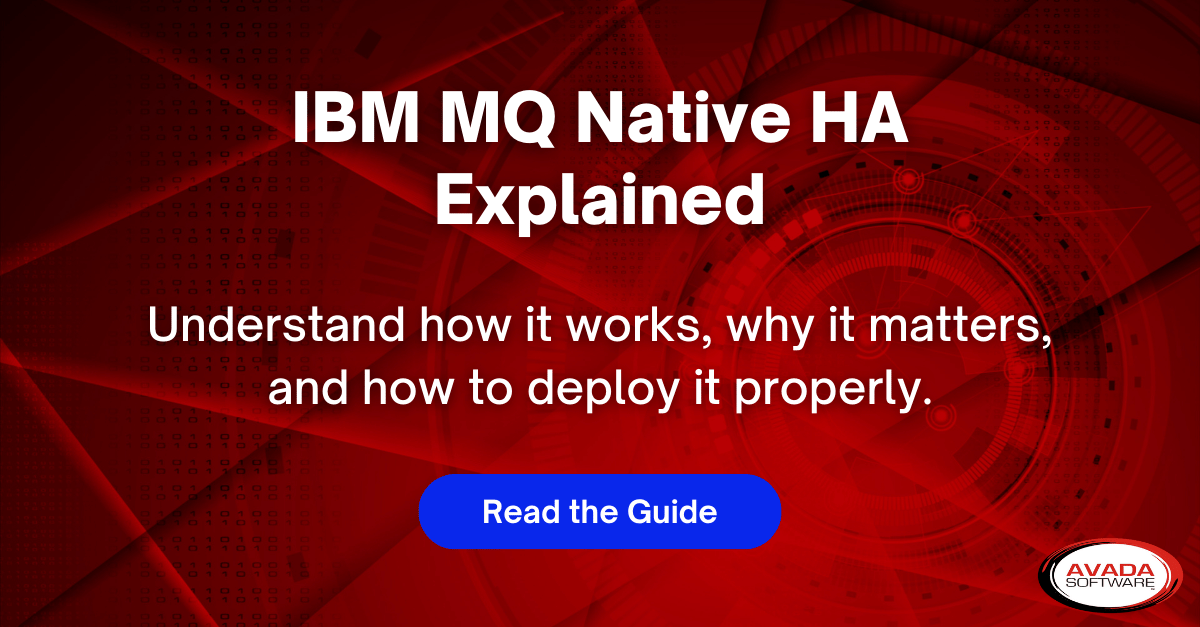- Understanding Synthetic Transactions: Proactive Testing for Robust Systems
- Why Use Synthetic Transactions for IBM MQ?
- Implementing Synthetic Transactions in IBM MQ: Best Practices for Success
- Examples of Synthetic Transactions in IBM MQ: Real-World Applications
- Infrared360: Enhancing Your Synthetic Testing for IBM MQ
- Conclusion: Proactive Testing for a Robust IBM MQ Environment
The Crucial Role of Synthetic Transactions in Testing IBM® MQ Environments
Messaging systems form the backbone of many modern enterprises, and IBM MQ is a leader in this space. However, ensuring these complex message environments are robust and reliable takes more than just hoping for the best. Synthetic transactions, by simulating real-world user interactions, provide a proactive way to test IBM MQ’s performance, resilience, and overall health.
In this guide, we’ll delve into the importance of synthetic transactions for IBM MQ, best practices for implementation, and how you can elevate your testing strategy. Let’s get started!
Understanding Synthetic Transactions: Proactive Testing for Robust Systems
Imagine a scenario where you can test your critical systems proactively, mimicking real-world user interactions without impacting live traffic. This is the power of synthetic transactions.
What are Synthetic Transactions?
In simpler terms, synthetic transactions act as stand-ins for real users. They simulate various user actions within a system, like logging in to an application or sending a message through a messaging queue. Think of them as automated test scripts that mimic real user behavior.
Why use Synthetic Transactions?
Traditional testing methodologies often rely on real user traffic, which can be risky (introducing errors into production) and reactive (waiting for issues to occur). Synthetic transactions offer a compelling alternative:
- Proactive Testing: They allow you to uncover potential problems before they impact real users. This proactive approach minimizes downtime and ensures a smoother user experience.
- Controlled Environments: Tests are conducted in isolated environments, separate from live traffic. This enables you to control variables and pinpoint the source of any issues that arise.
- Scalability and Repeatability: Synthetic transactions can be easily scaled to simulate high volumes of users or specific load conditions. Additionally, these tests can be automated and run repeatedly, ensuring consistent verification of system health.
By proactively testing your systems with synthetic transactions, you gain valuable insights into performance, identify potential bottlenecks, and ultimately build stronger, more resilient infrastructure.
Let’s dive deeper into why synthetic transactions are particularly valuable for IBM MQ environments. In the next section, we’ll explore the specific benefits of using synthetic transactions for robust IBM MQ testing.
Why Use Synthetic Transactions for IBM MQ?
As the complexity of enterprise messaging environments increases, so does the importance of proactive testing. IBM MQ, a cornerstone of many enterprise communication systems, necessitates rigorous testing to ensure its performance, reliability, and ability to seamlessly deliver messages. Synthetic transactions provide a powerful tool for achieving this.
Benefits of Synthetic Transactions for Robust IBM MQ Testing
Let’s explore the key advantages of leveraging synthetic transactions for your IBM MQ environment:
- Realistic Scenario Simulation: Go beyond basic “Hello World” tests. Synthetic transactions allow you to design scenarios that mimic real-world user interactions with high fidelity. This includes message size, content type (text, XML, JSON, etc.), headers, and various message properties.
- Performance Validation Under Load: Simulate varying message volumes and user loads to assess how your IBM MQ infrastructure handles peak traffic.
- Resilience Testing for Error Handling and Recovery: Introduce intentional errors or disruptions during synthetic transactions to evaluate your IBM MQ setup’s ability to handle exceptions and recover gracefully.
- End-to-End Testing for Message Flow Accuracy: Synthetic transactions verify the complete flow of a message through your IBM MQ infrastructure. This comprehensive testing identifies issues related to routing, queuing, or message delivery, ensuring reliable communication across your system.
The Power of Proactive Testing
By proactively testing your IBM MQ environment with synthetic transactions, you gain valuable insights into its performance, resilience, and overall health. This translates to:
- Reduced Downtime: Identify and address potential problems before they impact real users.
- Improved Reliability: Ensure consistent and reliable message delivery.
- Enhanced Scalability: Confidently handle fluctuating message volumes and peak loads.
- Peace of Mind: Gain confidence in the robustness of your messaging infrastructure.
Now, it’s time to explore the best practices for implementing synthetic transactions in your IBM MQ environment to maximize these benefits.
Implementing Synthetic Transactions in IBM MQ: Best Practices for Success
Now that you understand the benefits of synthetic transactions for IBM MQ, let’s turn our attention to implementation. Here are crucial best practices to ensure your synthetic testing strategy achieves maximum effectiveness:
Best Practices
Scenario Design
Develop scenarios that accurately reflect real-world use cases. Consider message sizes, types (text, binary, XML, JSON, etc.), frequencies, and potential variations you’d typically encounter in your IBM MQ environment. Focus on scenarios that expose potential pain points or test the limits of your system.
Comprehensive Coverage
Your synthetic transactions should span across the entire IBM MQ infrastructure. Test queues, channels, message exchange modes, and different configurations to ensure all components are functioning as expected.
Performance Metrics
Before implementing synthetic transactions, establish clear benchmarks for success. Define what constitutes acceptable throughput, latency, and error rates for your specific environment. This allows you to track progress and readily identify any deviations from desired performance.
Automation
Build automated testing procedures to enable frequent and consistent synthetic transactions. This promotes proactive identification of issues and helps track performance trends over time.
Integration with CI/CD
Seamlessly integrate your synthetic testing into continuous integration/continuous delivery pipelines. This ensures that changes to your IBM MQ infrastructure are tested automatically, catching potential problems early in the development cycle.
Putting Best Practices into Action
Here’s a quick summary of how these best practices translate into a robust synthetic testing strategy:
- Identify Scenarios: Work with stakeholders to pinpoint common interactions within your IBM MQ environment and any known pain points.
- Design Tests: Develop a library of synthetic transaction scenarios that represent these real-world use cases.
- Establish Benchmarks: Determine desired performance levels across key metrics to use for comparison.
- Automate: Create and schedule automated procedures for running synthetic transactions.
- Analyze and Iterate: Regularly review results, identify trends, and refine tests or benchmarks as needed.
By following these best practices, you’ll establish a powerful synthetic testing framework for your IBM MQ setup, leading to enhanced performance, reliability, and overall confidence in your messaging infrastructure.
Building on this, let’s examine examples of common synthetic transaction scenarios and their use cases within an IBM MQ environment.
Examples of Synthetic Transactions in IBM MQ: Real-World Applications
Let’s illustrate the best practices covered earlier with concrete examples of how synthetic transactions can be used within an IBM MQ environment.
Example Scenarios
- Basic Message Transfer: Simulate the fundamental scenario of sending and receiving messages between applications via IBM MQ. Vary the size, content type, and frequency of messages to mimic real-world usage patterns. This basic test validates core functionality and connectivity within your MQ environment.
- Load Balancing and Scalability: Gradually increase message volume and frequency in a synthetic transaction scenario to assess the ability of your IBM MQ infrastructure to handle peak loads. Observe metrics such as throughput and latency to identify any bottlenecks or potential scaling issues. This is crucial for ensuring the messaging system can adapt to demand fluctuations.
- Error Handling and Resilience: Introduce intentional errors into a synthetic transaction scenario, such as incorrect message formats, temporary queue unavailability, or network disturbances. This allows you to evaluate how well your IBM MQ setup identifies, reports, and recovers from these errors. Resilience testing helps minimize the impact of unexpected issues on real-world users.
Beyond the Basics: Tailoring Test Scenarios
These examples illustrate the principles of synthetic transaction testing, but the real power lies in customization. Adapt and expand upon these core scenarios to reflect the specific use cases and complexities within your own IBM MQ environment. Here are some questions to consider:
- Data Formats: What types of data (XML, JSON, binary, etc.) are commonly exchanged through your IBM MQ system?
- Error Conditions: What are common or critical error scenarios that your system should be able to handle gracefully?
- Business Processes: How can synthetic transactions simulate interactions that mirror real-world workflows within your organization?
By tailoring synthetic transactions to match your specific requirements, you create a powerful tool for proactively identifying weaknesses and proactively improving the robustness and reliability of your messaging infrastructure.
Now, let’s explore how a robust testing solution like Infrared360 can elevate your synthetic testing capabilities and provide superior insights into your IBM MQ environment’s health.
Infrared360: Enhancing Your Synthetic Testing for IBM MQ
While generic synthetic testing tools offer some benefits, specialized solutions like Infrared360 provide advanced capabilities specifically tailored to optimize IBM MQ testing. Let’s explore how Infrared360 sets itself apart:
Key Features for Enhanced MQ Testing
- Realistic Test Data Design: Infrared360 goes beyond simple “Hello World” tests, enabling you to craft scenarios with real-world data complexities. Generate messages in various sizes, character encodings, and formats (XML, JSON, binary, custom, etc.). Integrate headers and properties to simulate how your applications process and transform data as it traverses your IBM MQ infrastructure.
- Flexible Scenario Creation: Easily create scenarios with different message types and assign various headers/properties to simulate a wide range of use cases. Store these configurations in a library for future reuse or regression testing, promoting efficiency and consistency.
- Monitoring and Reporting: Gain deeper insights with Infrared360’s comprehensive monitoring and reporting. Track key performance metrics, identify trends, and receive actionable data to optimize your IBM MQ setup.
- CI/CD Integration: Streamline your testing process by integrating Infrared360 with your CI/CD pipelines. This ensures that any changes to your configuration are automatically tested, promoting agile development and reducing manual testing overhead.
The Power of Real-World Testing
Infrared360’s core strengths lie in its ability to mimic real-world complexities, empowering you to move beyond basic validation checks and identify issues that would otherwise go unnoticed in a live environment. This translates to greater reliability, reduced downtime, and a smoother user experience.
Conclusion: Proactive Testing for a Robust IBM MQ Environment
As the complexity of enterprise messaging systems continues to grow, synthetic transactions emerge as an indispensable tool for ensuring the performance, resilience, and overall health of your IBM MQ infrastructure. By proactively simulating real-world user interactions, you can uncover potential issues before they impact real users, safeguarding your business operations.
Key Benefits of Synthetic Transactions for IBM MQ:
- Reduced Downtime: Minimize disruptions and ensure consistent message delivery.
- Enhanced Scalability: Confidently handle fluctuating message volumes and peak loads.
- Improved Reliability: Proactively identify and address potential weaknesses in your system.
- Peace of Mind: Gain confidence in the robustness of your messaging infrastructure.
Infrared360 takes synthetic testing to the next level. Its ability to handle complex test data, customizable scenarios, advanced monitoring, and seamless integration into CI/CD pipelines make it an ideal solution for organizations seeking to maximize the effectiveness of their testing strategies.
See it for Yourself: If you’re ready to elevate your IBM MQ testing and ensure the reliability of your mission-critical messaging systems, explore Infrared360 today.
More Infrared360® Resources





























